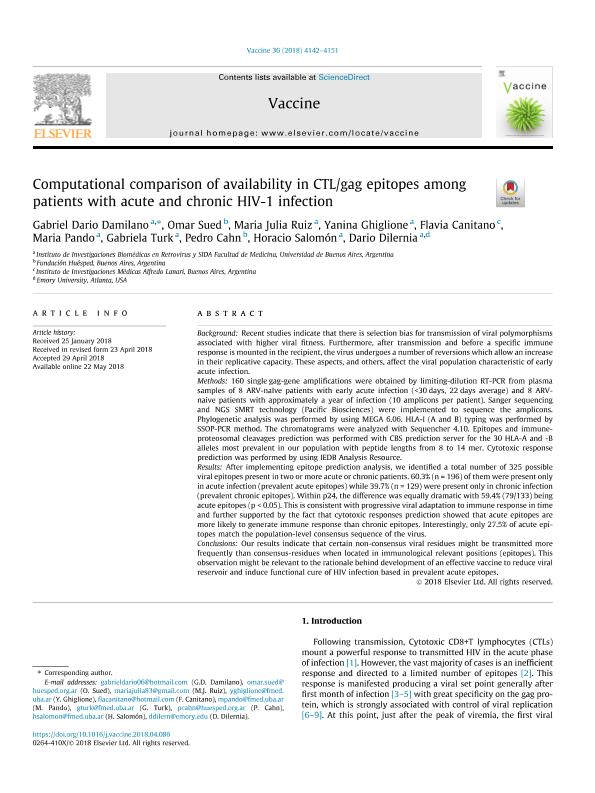Artículo
Computational comparison of availability in CTL/gag epitopes among patients with acute and chronic HIV-1 infection
Damilano, Gabriel Dario; Sued, Omar Gustavo; Ruiz, María Julia ; Ghiglione, Yanina Alexandra
; Ghiglione, Yanina Alexandra ; Canitano, Flavia; Pando, María de los Ángeles
; Canitano, Flavia; Pando, María de los Ángeles ; Turk, Gabriela Julia Ana
; Turk, Gabriela Julia Ana ; Cahn, Pedro Enrique; Salomon, Horacio Eduardo
; Cahn, Pedro Enrique; Salomon, Horacio Eduardo ; Dilernia, Darío Alberto
; Dilernia, Darío Alberto
 ; Ghiglione, Yanina Alexandra
; Ghiglione, Yanina Alexandra ; Canitano, Flavia; Pando, María de los Ángeles
; Canitano, Flavia; Pando, María de los Ángeles ; Turk, Gabriela Julia Ana
; Turk, Gabriela Julia Ana ; Cahn, Pedro Enrique; Salomon, Horacio Eduardo
; Cahn, Pedro Enrique; Salomon, Horacio Eduardo ; Dilernia, Darío Alberto
; Dilernia, Darío Alberto
Fecha de publicación:
27/06/2018
Editorial:
Elsevier
Revista:
Vaccine
ISSN:
0264-410X
Idioma:
Inglés
Tipo de recurso:
Artículo publicado
Clasificación temática:
Resumen
Background: Recent studies indicate that there is selection bias for transmission of viral polymorphisms associated with higher viral fitness. Furthermore, after transmission and before a specific immune response is mounted in the recipient, the virus undergoes a number of reversions which allow an increase in their replicative capacity. These aspects, and others, affect the viral population characteristic of early acute infection. Methods: 160 single gag-gene amplifications were obtained by limiting-dilution RT-PCR from plasma samples of 8 ARV-naïve patients with early acute infection (<30 days, 22 days average) and 8 ARV-naive patients with approximately a year of infection (10 amplicons per patient). Sanger sequencing and NGS SMRT technology (Pacific Biosciences) were implemented to sequence the amplicons. Phylogenetic analysis was performed by using MEGA 6.06. HLA-I (A and B) typing was performed by SSOP-PCR method. The chromatograms were analyzed with Sequencher 4.10. Epitopes and immune-proteosomal cleavages prediction was performed with CBS prediction server for the 30 HLA-A and -B alleles most prevalent in our population with peptide lengths from 8 to 14 mer. Cytotoxic response prediction was performed by using IEDB Analysis Resource. Results: After implementing epitope prediction analysis, we identified a total number of 325 possible viral epitopes present in two or more acute or chronic patients. 60.3% (n = 196) of them were present only in acute infection (prevalent acute epitopes) while 39.7% (n = 129) were present only in chronic infection (prevalent chronic epitopes). Within p24, the difference was equally dramatic with 59.4% (79/133) being acute epitopes (p < 0.05). This is consistent with progressive viral adaptation to immune response in time and further supported by the fact that cytotoxic responses prediction showed that acute epitopes are more likely to generate immune response than chronic epitopes. Interestingly, only 27.5% of acute epitopes match the population-level consensus sequence of the virus. Conclusions: Our results indicate that certain non-consensus viral residues might be transmitted more frequently than consensus-residues when located in immunological relevant positions (epitopes). This observation might be relevant to the rationale behind development of an effective vaccine to reduce viral reservoir and induce functional cure of HIV infection based in prevalent acute epitopes.
Palabras clave:
CTL
,
HIV
,
ACUTE INFECTION
,
EPITOPES
Archivos asociados
Licencia
Identificadores
Colecciones
Articulos(INBIRS)
Articulos de INSTITUTO DE INVESTIGACIONES BIOMEDICAS EN RETROVIRUS Y SIDA
Articulos de INSTITUTO DE INVESTIGACIONES BIOMEDICAS EN RETROVIRUS Y SIDA
Citación
Damilano, Gabriel Dario; Sued, Omar Gustavo; Ruiz, María Julia; Ghiglione, Yanina Alexandra; Canitano, Flavia; et al.; Computational comparison of availability in CTL/gag epitopes among patients with acute and chronic HIV-1 infection; Elsevier; Vaccine; 36; 28; 27-6-2018; 4142-4151
Compartir
Altmétricas



